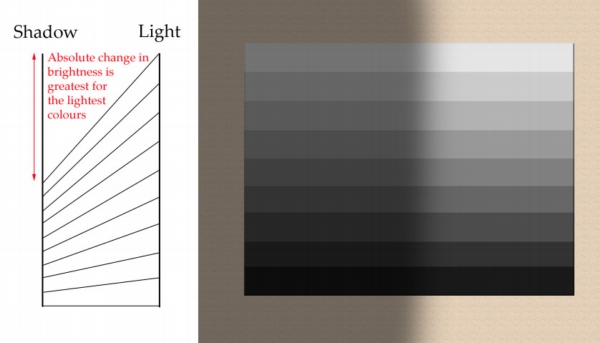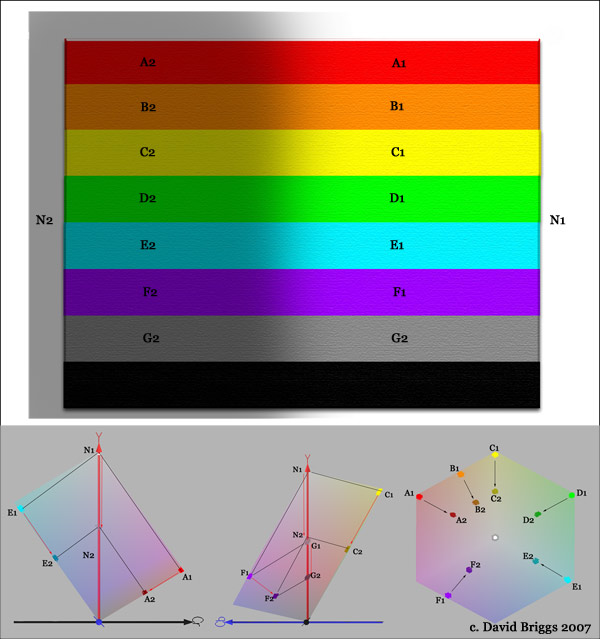my colour short course is
now offered online through
Australia's National Art
School in Sydney! There's
a choice of two sessions to
suit every time zone. LINK
Home
The Dimensions of Colour
Basics of Light and Shade
Basics of Colour Vision
Additive Mixing
Subtractive Mixing
Mixing of Paints
Hue
Lightness and Chroma
Brightness and Saturation
Principles of Colour
- Shading Series
- Consistency of Relative Brightness
- The Scale of Brilliance
- Effect of Coloured Illumination
- Effect of Multiple Light Sources
- Effect of Distance From Light
- Effect of Inclination to Light
- Effects of Atmosphere
- Applying the Principles in Paint
Glossary
References
Contact
Links
NEXT COLOUR
WORKSHOPS

2. CONSISTENCY OF RELATIVE BRIGHTNESS
When several coloured surfaces pass together into different levels of illumination they maintain constant ratios of relative brightness (B).
If the brightness of appearance of two greyscale colours differs by a factor of x at a given level of illumination, they will differ by the same factor at any other level of that illumination (Figure 10.4). This is because the difference in the amount of light energy reflected is determined only by the relative reflectance of the two surfaces. This rule works both with linear radiance and with nonlinear brightness (B). It doesn't quite work with nonlinear lightness (L) because of the different way L is calculated.

Figure 10.4. Greyscale colours in shadow and light, demonstrating how relative brightness of appearance is maintained.
Note that the fact that relative differences of brightness are maintained means that absolute differences between the different tones are less in the shadows than in the light, and conversely that the absolute change in tone between light and shadow is greatest for light tones and least for dark tones. Note also that the frequently quoted rule that the lightest tone in the shadow must be darker than the darkest tone in the light is simply not true. This "rule" may possibly have arisen from a simple misunderstanding of the principle that the lightest occurrence of a given colour in the shadow will be darker than the darkest occurrence of the same colour in the light.
In Photoshop, relationships of constant relative brightness can be created very easily using either of the two shortcuts mentioned under Principle One, varying the opacity of the image layer in normal mode over a layer of black, or varying the opacity of a layer of black in multiply mode over the image layer.
For coloured surfaces, the same rule of maintenance of relative brightness also applies (provided that the light sources do not differ in spectral composition). "Colorfulness" of appearance, and hence the chroma of the image colour used to represent that appearance, diminish with the diminishing brightness (Figure 10.5). The saturation of the light given off by the surface, and of course the perceived chroma of the surface itself remain the same.

Figure 10.5. Colour relationships in light and shade. Above. Effect of two different light levels on appearance of a group of surface colours, and the same colours in YCbCr, showing how patterns of relative brightness are maintained. Below: Interactive demonstration of effect of different light levels on a set of surface colours, emulated here by varying the opacity of layers over black.
